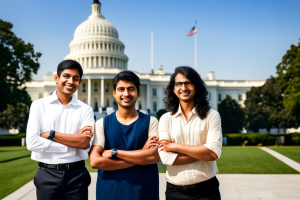Support migrant centric journalism today and donate

United States Citizenship and Immigration Services (USCIS) and the Department of Homeland Security (DHS) published a long-awaited, final rule to “update and improve” certain employment-based nonimmigrant and immigrant visa programs. The proposed rule was first published in the Federal Register on December 31, 2015. The final rule comes into force on 17 January 2017 shortly before Donald Trump becomes the 45th President of the United States on 20 January 2017.
Those applying for employment based immigrant visas such as the EB1, EB2, EB3 employment based immigrant visa schemes and those those on the following US non-immigrant visa categories may benefit from the change of immigration rules.
- E1 Treaty Trader Visa
- E2 Treaty Investor Visa
- E3 Visa for Australians in specialty occupations
- H1B visa for those in specialty occupations usually with a bachelors degree or higher.
- H1B1 for nationals of Singapore and Chile
- L1A Intra-company transfer visas for Executives and Managers
- L1B intra-company transfer visas for specialized knowledge employees.
The final rule comes into effect on January 17, 2017 and includes amended regulations – made by USCIS - that it is said will help American employers to sponsor and retain certain foreign workers who benefit from approved employment-based immigrant visa petitions and are waiting to become lawful permanent residents. The rule iputs in writing practices that are largely already followed when there are pending US visa applications.
According to the Asian American Press and other sources, the DHS is making the following changes to its regulations:
- The rule clarifies DHS policies and practices that largely already apply to foreign workers. This should make the USCIS more consistent and fair when assessing petitions
- USCIS says that the rule helps American employers hire and retain highly-skilled foreign personnel filing EB1, EB2 and EB3 employment-based immigrant visa petitions
The final rule gives foreign workers the opportunity to advance their careers via workplace promotion, changing job roles with current employers, switching employers and pursuing other employment opportunities.However, surely flexibility of employment may mean that some employees choose to leave their current employer and find a new employer.
- Make transferring between jobs easier for foreign workers granted an employment-based visa, regardless of an employer’s withdrawal of an approved petition or the closure of an employer’s business
- Expand the length of time highly-skilled foreign workers can retain their priority date when filing for adjustment of status to lawful permanent residence.
- This will allow certain highly-skilled foreign nationals in the US holding E-3, H-1B, H-1B1, L-1 or O-1 nonimmigrant status, including any applicable grace period, to file for employment authorization for a limited period provided that:
- They are the primary beneficiary of an approved I-140 employment based immigrant petition.
- An immigrant visa is not authorized for issuance for their priority date.
- They can provide convincing evidence that would justify the DHS issuing an employment authorization document at their discretion.
- Such employment authorization may only be renewed in limited circumstances and only in 12 month increments.
- They are the primary beneficiary of an approved I-140 employment based immigrant petition.
- Introduce two grace periods of up to 10 days at the beginning and end of work validity period for people holding E-1, E-2, E-3, L-1, and TN nonimmigrant status, to provide a reasonable amount of time for these individuals to prepare to begin employment in the country and to depart the United States or take other actions to extend, change, or otherwise maintain lawful status
- Establish a one time grace period of up to 60 consecutive days or for the validity of their visa whichever is shorter after employment ends to allow for a change of employment for certain highly-skilled nonimmigrant workers on E-1, E-2, E-3, H-1B, H-1B1, L-1, O-1, or TN visa status, so they can more readily pursue new employment and an extension to nonimmigrant status
- Automatically extend the employment authorization and validity of Employment Authorization Documents (EADs or Form I-766s) for certain individuals who apply on time to renew their EADs
- Eliminate the regulatory provision that requires USCIS to adjudicate the Form I-765, Application for Employment Authorization, within 90 days of filing and that authorizes interim EADs in cases where such adjudications are not conducted within the 90-day timeframe
- Under the AC21 (American Competitiveness in the Twenty-First Century Act of 2000) job portability is allowed enabling the employee to work for another employer if the I-140 adjustment of status immigrant petition application has been pending for 180 days or more and the employee wishes to work in a similar field of work: The employment may be provided by the employer who submitted the petition, from a different U.S. employer or based on self-employment. DHS proposes to amend rules to prohibit approval of an immigrant adjustment of status application in a situation where the I-140 immigrant visa petition has been revoked. However, automatic revocations should be less frequent under the proposed rule. This will include cases where the initial petitioning employer has gone out of business since the I-140 approval. The immigrant visa applicant will either have to complete the supplementary form I-485 in portability cases along with details of the new job and that it meets the portability requirements.
- H1B visa holders can also benefit from portability and can have successive H-1B Change of Employer petitions filed on his or her behalf. As long as the H-1B portability petition meets H1B visa requirements and an extension of stay the skilled worker will have work authorisation.
- Those who have held H-1B visa status may stay beyond the usual maximum six year period if they have an approved I140 immigrant petition and have applied for immigrant adjustment of status or and immigrant visa within one year of an immigrant visa being authorised for issuance.
A complete copy of the final rule can be found on the Federal Register website. This final immigration rule largely clarifies existing practices and should be helpful to many immigrants in the US.





















